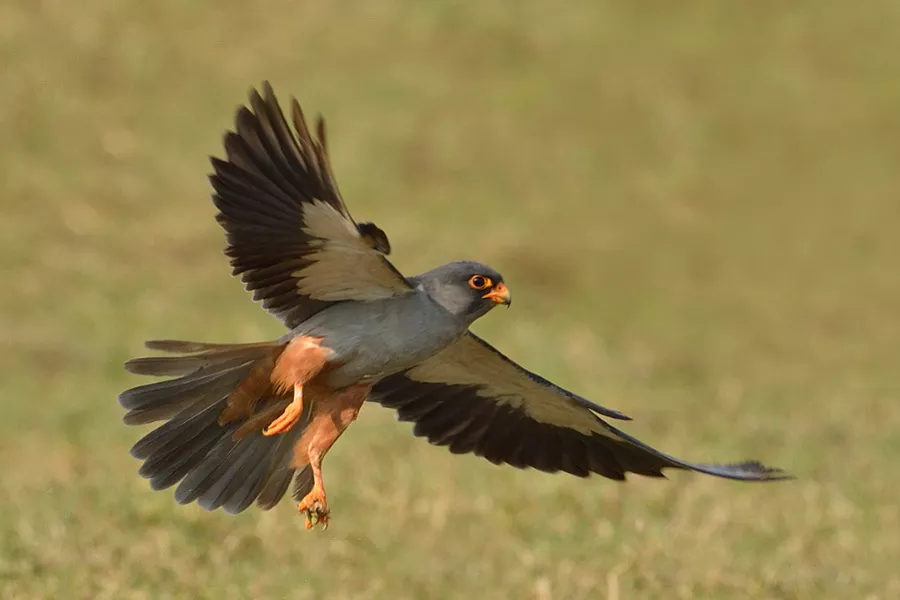The Amur Falcon (Falco amurensis) is a small raptor known for its impressive migratory journey from northeastern Asia to southern Africa. Throughout this extensive migration, the Amur Falcon relies on a diet primarily composed of insects, supplemented by small vertebrates during specific periods. Understanding the feeding habits of the Amur Falcon provides valuable insights into its ecological role and the challenges it faces during migration.
Primary Diet: Insects
Insects form the cornerstone of the Amur Falcon’s diet, especially during migration and in non-breeding areas. Studies have shown that during their autumn passage through northeastern India, Amur Falcons predominantly consume insects from five taxonomic orders:
- Orthoptera: Grasshoppers and crickets
- Isoptera: Termites
- Hemiptera: True bugs
- Coleoptera: Beetles
- Hymenoptera: Ants and wasps
Among these, termites (Isoptera) are particularly abundant in the diet, with a frequency of occurrence of 87% across various stopover sites in Nagaland, India.
The abundance of these insects during migration provides essential nourishment for the Amur Falcons, supporting their energy needs during long flights.
Diet During Migration
The Amur Falcon’s migration is a remarkable journey, covering thousands of kilometers. During this time, the diet remains predominantly insectivorous. The timing of their migration coincides with the emergence of large swarms of insects, such as termites, locusts, ants, and beetles, especially in regions like southern Africa. These swarms offer ample food resources, allowing the falcons to replenish their energy reserves.
Diet in Breeding and Non-Breeding Areas
While insects are the primary food source during migration, the Amur Falcon’s diet diversifies in its breeding and non-breeding habitats.
- Breeding Areas: In regions like northeastern India, the Amur Falcon feeds on a variety of insects, including termites, grasshoppers, and beetles. Occasionally, they may also consume small vertebrates such as rodents and small birds.
- Non-Breeding Areas: In southern Africa, the diet remains largely insectivorous, with a focus on insects like termites, locusts, ants, and beetles. These insects are abundant during the rainy season, providing a rich food source for the falcons.
Foraging Behavior
Amur Falcons are adept hunters, employing various techniques to capture their prey:
- In Flight: They often catch insects mid-air, showcasing agility and precision.
- Hovering: Similar to kestrels, Amur Falcons can hover in place, scanning the ground for insects.
- Ground Foraging: They may also land to pick up insects from the ground, especially when insects are abundant.
This versatile foraging behavior enables them to exploit a wide range of habitats and food sources.
Nutritional Requirements
The diet of the Amur Falcon is rich in protein and essential nutrients, which are crucial for:
- Migration: Sustaining energy levels during long flights.
- Reproduction: Supporting the development of eggs and feeding of chicks.
- Molting: Facilitating the growth of new feathers.
The availability of insect prey during migration and in non-breeding areas is vital for meeting these nutritional needs.
Conservation Implications
Understanding the Amur Falcon’s diet is essential for conservation efforts. Protecting their feeding habitats, especially during migration and in non-breeding areas, ensures the availability of food resources. Conservation initiatives in regions like Nagaland, India, have been successful in preventing the mass trapping of migrating Amur Falcons, highlighting the importance of habitat protection and public awareness.
Conclusion
The Amur Falcon’s diet is primarily composed of insects, supplemented by small vertebrates during specific periods. Their feeding habits are closely linked to their migratory patterns and the availability of food resources in different habitats. Protecting these habitats and ensuring the availability of food sources are crucial for the conservation of this remarkable species.


 Facebook
Facebook  Instagram
Instagram  Youtube
Youtube 